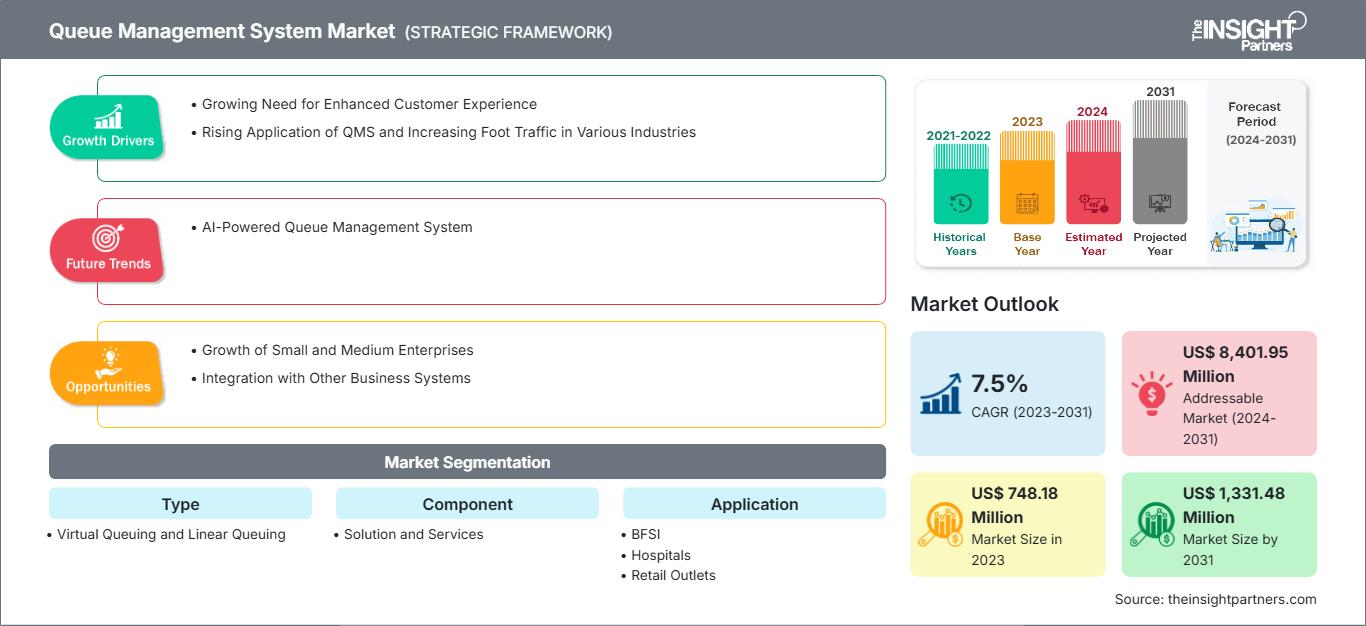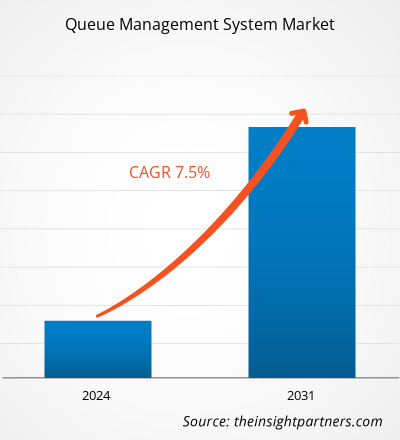预计到 2031 年,排队管理系统市场规模将从 2023 年的 7.4818 亿美元增至 13.3148 亿美元。预计该市场在 2023 年至 2031 年期间的复合年增长率为 7.5%。对人工智能排队管理系统日益增长的需求可能会在未来几年为市场带来新的趋势。
排队管理系统市场分析
增强客户体验的需求、QMS 应用的兴起以及各行各业客流量的增加等因素正在推动排队管理系统市场的发展。由于中小企业 (SME) 的增长、对虚拟排队管理的需求不断增长以及 QMS 与其他业务系统的集成,预计市场将在预测期内增长。人工智能排队管理系统的兴起是市场的一个关键趋势。此外,云技术的兴起以及虚拟排队和移动售票等先进解决方案的采用,改变了企业与客户互动的方式,从而提高了灵活性和效率。医疗保健、零售和银行业是这一增长的主要贡献者,因为它们越来越多地实施队列管理系统 (QMS) 来处理不断增长的客户量并提高运营效率。此外,这些系统中集成的数据分析功能提供了宝贵的洞察,可帮助企业优化服务流程,最终推动产品采用和市场扩张。
队列管理系统市场概览
队列管理系统 (QMS) 包含用于管理和分析队列中客户或访客流量的工具。该系统旨在通过减少最终用户的等待时间来优化运营效率。队列管理系统可帮助服务提供商增强服务交付、提高员工生产力并简化排队体验。多年来,由于对高效便捷地构建和管理队列的需求不断增长,队列管理系统市场一直保持稳步增长。多年来,队列管理系统的最终用户数量持续激增。该系统专为满足零售商店、金融服务业、医疗保健、政府部门和教育机构的需求而定制。例如,根据国际机场协会 (ACI) 的数据,从 2022 年到 2040 年,客运量年均增长率为 5.8%,到 2040 年,每年将有超过 190 亿旅客使用机场。预计在预测期内,这将增加机场排队管理系统的采用率。
自定义此报告以满足您的要求
您将免费获得任何报告的定制,包括本报告的部分内容,或国家级分析、Excel 数据包,以及为初创企业和大学提供超值优惠和折扣
排队管理系统市场: 战略洞察

-
获取本报告的主要市场趋势。这个免费样本将包括数据分析,从市场趋势到估计和预测。
排队管理系统市场驱动因素和机遇
对提升客户体验的需求日益增长
企业越来越意识到,管理客流和减少等待时间可以显著提高客户满意度。每一次互动,无论是退货、维修还是解答问题,都在塑造客户与企业之间未来的关系中发挥着重要作用。根据Qtrac的调查,93%的消费者表示,如果企业提供卓越的客户服务,他们更有可能成为回头客。此外,根据Zendesk的调查,73%的消费者表示,在与一家企业有过几次不愉快的体验后,他们可能会转向竞争对手。这一统计数据凸显了保持高质量客户服务和持续积极互动的重要性。在竞争激烈的市场环境下,消费者拥有众多选择,企业绝不能忽视客户体验对留存率的影响。客户转换的决定通常不仅取决于即时体验,还取决于过去互动的累积效应。为了降低客户流失的风险,企业必须主动解决潜在问题,征求客户反馈,并根据反馈实施改进。通过优先提供卓越服务并展现对客户满意度的承诺,企业可以培养客户忠诚度,并降低客户转向竞争对手的可能性。这种优先考虑客户体验的转变正在鼓励企业采用排队管理解决方案。
人口的快速增长是导致医院、零售商店、诊所、机场和其他设施排队混乱的主要因素,这会导致人群感到沮丧并降低服务质量。此外,在营业高峰时段,排队人数持续激增,工作人员不得不手动管理排队,这会导致服务质量下降。根据米德兰兹技术学院 2022 年 1 月的数据,由于服务质量差和客户不满,企业正在失去潜在客户。数据估计,糟糕的客户服务每年会造成 750 亿美元至 1.6 万亿美元的业务损失,原因包括排队时间过长、成本削减策略、缺乏对客户需求的了解以及为了增长而牺牲客户满意度等。预计未来几年,这种收入损失还会进一步增加,导致客户转向竞争对手的产品,从而导致潜在客户流失。为了高效管理排队和提高服务质量,各服务提供商都选择使用排队管理解决方案。因此,对增强客户体验日益增长的需求推动了排队管理系统市场的发展。
中小企业的增长
预计在预测期内,中小企业 (SME) 的增长将为排队管理系统市场的扩张带来巨大的机遇。中小企业通常以其敏捷性和适应性为特点,这使得它们能够比大型企业更有效地开发出满足特定客户需求的定制解决方案。 2022年,占欧盟企业总数约99%的中小企业通常更加敏捷,更具创新精神,这使得它们能够采用QMS等先进技术来提升客户体验和运营效率。此外,根据经济合作与发展组织(OECD)的数据,2021年,中小企业在许多国家的经济格局中发挥着至关重要的作用,贡献了约50%的总就业岗位和40%的国内生产总值(GDP)。随着中小企业不断发展壮大并寻求竞争优势,排队管理系统(QMS)的采用率将会提高,因为这些企业认识到提高运营效率和客户体验的重要性。随着中小企业的扩张,客户对快速高效服务的期望也越来越高,因此有效管理客户流量至关重要。排队管理系统为这些企业提供了简化运营、减少等待时间和改善整体服务交付的工具,这对于在竞争激烈的市场中留住客户至关重要。此外,中小企业整合数字化解决方案的趋势日益普遍,这使得它们能够实施先进的质量管理体系 (QMS),利用实时数据分析来优化服务流程。这一趋势不仅提高了客户满意度,还支持中小企业提高生产力和运营效率,最终推动其在市场上的可持续发展。
排队管理系统市场报告细分分析
促成排队管理系统市场分析的关键细分领域包括类型、组件和应用。
- 根据类型,排队管理系统市场可分为虚拟排队和线性排队。虚拟排队细分领域在2023年占据了市场主导地位。
- 根据组件,排队管理系统市场可分为解决方案和服务。 2023 年,解决方案部分占据了更大的市场份额。
- 在应用方面,排队管理系统市场分为 BFSI、医院、零售店、餐厅、公用事业服务提供商和机场、政府办公室等。零售店部分在 2023 年占据了市场主导地位。
按地域划分的排队管理系统市场份额分析
- 排队管理系统市场分为五大区域:北美、欧洲、亚太地区 (APAC)、中东和非洲 (MEA) 以及南美和中美。2023 年,北美占据了市场主导地位,其次是欧洲和亚太地区。
- 北美在排队管理系统市场占据主导地位,其次是欧洲和亚太地区。北美市场的主导地位主要与众多最终用户行业的存在有关。北美排队管理系统市场的发展受到医疗保健、航空和零售行业使用率上升的推动。整个地区对医疗保健行业先进技术的投资正在迅速增长。据 JAHANI AND ASSOCIATES LLC 的数据,受新冠疫情的影响,2022 年美国医疗保健行业的资本市场活动有所增加。医疗保健行业获得了 1100 亿美元的投资,用于开发旨在改善医疗服务的技术。此外,医疗保健行业约 45% 的交易是并购 (M&A) 交易,这些交易由公司进行,旨在开发现有技术。由于就诊患者数量的增加,医疗保健行业的扩张正在推动整个地区市场的增长。此外,北美拥有更高的排队管理系统硬件制造商和软件开发商集中度,这使得最终用户可以从各种供应商处采购系统。此外,随着系统供应商和最终用户数量的不断增加,加拿大和墨西哥的排队管理系统市场也正在迅速普及。因此,采购率的上升正在推动北美排队管理系统市场的发展。
排队管理系统市场
队列管理系统市场
The Insight Partners 的分析师已详尽阐述了预测期内影响队列管理系统市场的区域趋势和因素。本节还讨论了北美、欧洲、亚太地区、中东和非洲以及南美和中美洲的队列管理系统市场细分和地域分布。
队列管理系统市场报告范围
| 报告属性 | 细节 |
|---|---|
| 市场规模 2023 | US$ 748.18 Million |
| 市场规模 2031 | US$ 1,331.48 Million |
| 全球复合年增长率 (2023 - 2031) | 7.5% |
| 历史数据 | 2021-2022 |
| 预测期 | 2024-2031 |
| 涵盖的领域 |
By 类型
|
| 覆盖地区和国家 |
北美
|
| 市场领导者和主要公司简介 |
|
队列管理系统市场参与者密度:了解其对业务动态的影响
排队管理系统市场正在快速增长,这得益于终端用户需求的不断增长,而这些需求的驱动因素包括消费者偏好的演变、技术进步以及对产品优势的认知度的提升。随着需求的增长,企业正在扩展其产品线,不断创新以满足消费者需求,并利用新兴趋势,从而进一步推动市场增长。

- 获取 排队管理系统市场 主要参与者概述
排队管理系统市场新闻及最新发展
排队管理系统市场评估是通过收集一手和二手研究后的定性和定量数据进行的,这些数据包括重要的公司出版物、协会数据和数据库。排队管理系统市场的一些发展如下:
- 研华宣布收购Aures Technologies SA,这是一家以其POS和KIOSK品牌而闻名的法国公司。这一战略举措旨在加强研华在智能零售产品和服务方面的全球覆盖,提升其在全球领先智能零售解决方案提供商中的地位。(来源:研华,新闻稿,2024年4月)
- Wavetec宣布扩大与旁遮普银行的合作伙伴关系。该银行在其各分行安装了300套排队管理系统(QMS)。 (来源:Wavetec,新闻稿,2024 年 6 月)
队列管理系统市场报告覆盖范围和可交付成果
“队列管理系统市场规模和预测(2021-2031)”提供了详细的市场分析,涵盖以下领域:
- 队列管理系统市场规模和预测,涵盖范围内所有关键细分市场的全球、区域和国家/地区
- 队列管理系统市场趋势以及市场动态,例如驱动因素、限制因素和关键机遇
- 详细的 PEST 和 SWOT 分析
- 队列管理系统市场分析,涵盖关键市场趋势、全球和区域框架、主要参与者、法规和最新市场发展
- 行业格局和竞争分析,涵盖市场集中度、热图分析、知名参与者和队列管理系统市场的最新发展
- 详细的公司简介
- 历史分析(2 年)、基准年、预测(7 年)及复合年增长率
- PEST和SWOT分析
- 市场规模、价值/数量 - 全球、区域、国家
- 行业和竞争格局
- Excel 数据集
近期报告
相关报告
客户评价
购买理由
- 明智的决策
- 了解市场动态
- 竞争分析
- 客户洞察
- 市场预测
- 风险规避
- 战略规划
- 投资论证
- 识别新兴市场
- 优化营销策略
- 提升运营效率
- 顺应监管趋势






















 获取免费样品 - 排队管理系统市场
获取免费样品 - 排队管理系统市场